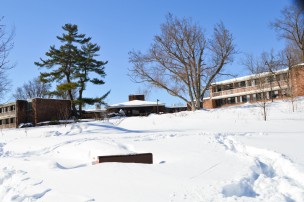
The University’s Wild Walls student group announced this week that it plans to build a “living wall”—or vertical plant wall—on campus this semester. The group’s main focus is redesigning conventional campus landscaping while promoting self-sustaining ecosystems. Their living wall will be located directly outside of Weshop and will most likely display a variety of succulents and herbs.
Kate Weiner ’15 originally proposed the project as part of her aspiration to introduce more green spaces on campus.
“We wanted to transform green spaces on campus and encourage people to see land use, landscaping, and gardening in a different light,” Weiner said. “I think vertical gardening is really space-efficient and beautiful.”
Nicole Stanton ’15 is also taking part in the project, and believes that it will be beneficial to students who spend the majority of their time inside.
“I think more green space on campus could only be a good thing,” Stanton wrote in an email to The Argus. “It is also a fantastic group of dedicated people working with Wild Walls, all interested in different degrees in promoting sustainability on campus. Having living walls on campus will hopefully be a reminder to the Wesleyan community that despite being often holed up in cement and brick and structured space, the green spaces hold the soul stuff.”
Weiner, along with five others, attempted to create a trial wall during the fall semester. The group bought a variety of succulents and recycled palette wood from Home Depot in order to assemble the prototype. They constructed it outside of Weshop with a limited amount of time and money.
“Last semester was all about promoting the feasibility of the living wall,” Stanton wrote. “The bit of green got a lot of love and attention! Now it’s all about executing a permanent version of last semester’s baby.”
Noelle Hiam ’15 participated in the trial project and is optimistic about further student involvement.
“What’s cool about the spot [we chose] is that it is such a public area with a lot of traffic so a lot of people would come by and be interested,” Hiam said.“I feel like once we start doing stuff there, tons of people will start to come and help out.”
The group received funding from the Wesleyan Green Fund and plans to begin the construction of the wall during the coming weeks. Founded in 2010, the Wesleyan Green Fund issues grants to finance projects dedicated to decreasing the carbon footprint and increasing sustainability efforts on campus. The Fund issues about $85,000 annually through an optional $15 donation that is attached to students’ tuitions.
While they have yet to decide what type of plants they will use, most members of the project seem to be in favor of creating an herb or other type of edible wall.
“We have to start building it relatively soon since spring break is coming up, but it will be up in April and May when it’s warmer,” Weiner said.
Weiner has already begun preparation for the project.
“I just bought 40 wooly pockets,” Weiner said. “They are plastic vertical garden boxes that are designed specially for building walls because they have a water filtration system in them, and you don’t need to water them as much.”
While most students involved seem to be looking forward to beginning construction on the living wall, Hiam voiced a few of her concerns.
“Our biggest concern[s are] squirrels because they got into some of our succulents [as well as] people just taking succulents which has happened,” she said.
The group plans to hold recruitment and planning meetings in the upcoming weeks. They are looking for students that are passionate about gardening, building, and improving the campus.


Leave a Reply